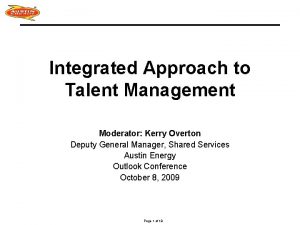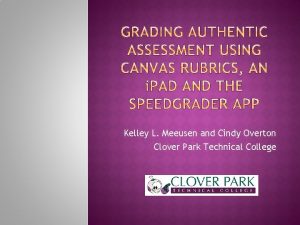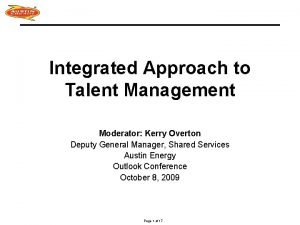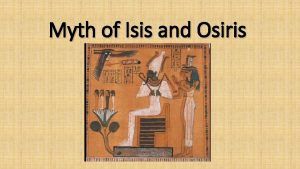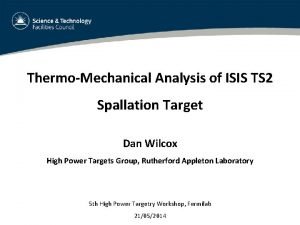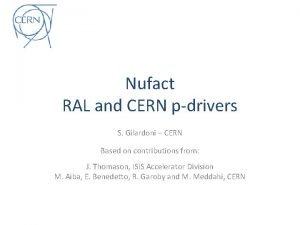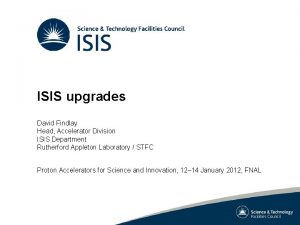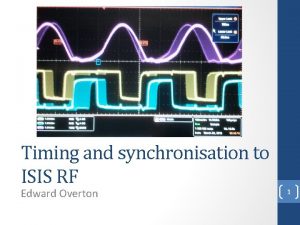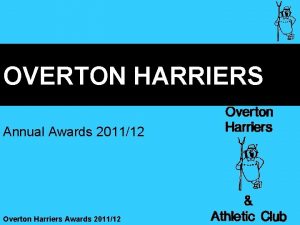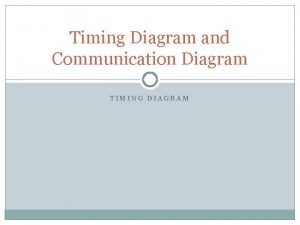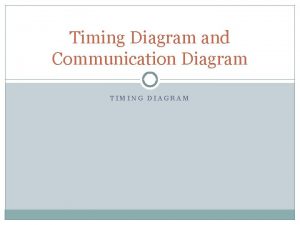Tracker Timing and ISIS RF Edward Overton 1










- Slides: 10

Tracker Timing and ISIS RF Edward Overton 1

At CM 32… • Had done some preliminary checks on the ISIS RF. • Was beginning to think about how to handle the RF to generate the appropriate windows for the trackers. Since then • Repeated checks on the ISIS RF and measured relative trigger delays. • Implemented (and tested) a system to generate the appropriate windows for the single station test. • Measured the effect on trigger rate of applying a trigger veto based off the ISIS RF (alive window). • Begun thinking about timing the tracker to the TOFs. 2

Why ISIS RF? • The Tracker uses Analogue Front End (AFE) boards from D 0 to read out the charge produced from the photon counters (VLPC’s). Integration window Charge Arrival • The AFE boards integrate charge which arrives in a predefined integration window, which can then be read out later. Integrated charge • We need to ensure all light is collected for a readout trigger. So we only accept triggers inside an “alive window”. • We need to synchronise the windows to particles inside the tracker. . Discriminator TDC (started by discriminator) Time • The particles are bunched in ISIS and kept synchronised to the ISIS RF. • The particles in MICE should share this structure. • The ISIS Reference RF signal is fairly clean and can be provided by ISIS. 3

Trigger Correlation to the ISIS RF • This was checked initially in the December run, but needed to be repeated in the March run due to a badly configured Oscilloscope. ISIS 1 RF Delay • The RF signal was connected from ISIS into the DAQ Oscilloscope in the MLCR, so that the entire signal could be recorded for the entire ISIS cycle (200 MS/s, 20 ms). • Additionally the particle trigger (from TOF 1) and TOF 0 triggers were connected to the scope. • A simple ROOT script then finds the rising edge of the RF sine wave and the time of the particle triggers and computes the delay… Particle trigger 4

Measured Delay for Pions • Plot on left shows the trigger delays for 15 -20 Spills. With three different beams. Line Colour: B: 360 Me. V/c G: 255 Me. V/c R: 200 Me. V/c • Majority of particles arriving in 300400 ns, but a noticeable number of outliers. • I checked the timing of these and they are not coincident (within 300 ns) of a hit in TOF 0… So I don’t expect they come from ISIS. • Alive window will only accept triggers for 120 ns out of every 330 ns. . But this should not affect the trigger count if get the timing right. Delay (ns) 5

Frequency Change • One difficulty with the synchronisation is that the frequency is constantly changing. • While the window widths are fixed, the time between windows changes. This adds a level of complexity to the system as there are fixed delays to the hall and changing delays between windows. • We need to make sure that all the charge is collected during the entire spill gate. • We do this by using an 80 ns smaller alive window than the integration window to ensure a complete overlap even as the RF changes. • This problem gets easier with smaller spill gates. 6

Handling the RF • Need to generate independent configurable windows that can be moved in time from the ISIS RF. • This is done using two T 560 delay boxes in the rack room and some NIM logic. The boxes can be configured over micenet using a simple python script. 80 ns/div ISIS RF Integration Window (200 ns) Alive Window (120 ns) 7

• We measured the effect of the alive window on the trigger rate, while moving the alive window. • There was no digitisation dead time included for this study for the tracker (normally 6 us). • We recorded the number of triggers on the scalars for 10+ spills. • On average there were 150 Triggers / spill. • The alive window reduces the fraction of accepted triggers to 78% from 86% at this rate. • I have plans to use a run where the rate was changed to see how the trigger rate would be effected by the 6 us digitisation window of the tracker. Acccepted Triggers / Trigger Requests Trigger Rate 1 120 ns window 0, 9 30 ns window Maximum 0, 8 0, 7 0, 6 0, 5 0, 4 0, 3 0, 2 0, 1 0 50 Alive Window Offset Time (ns) 8

Timing to other Detectors • The tracker calculates time relative to the end of an integration window. • The TOFs record the relative time of the particle trigger. • We need a way to link the two! • Could handle this by recording the time at the end of an integration window with a TOF TDC card. This would give the relative time between particle trigger and integration window. • Need to think a little though as the long cable to the hall means the closest integration window to the trigger won’t be the one that was sent into the hall 500 ns ago. The frequency of the windows is changing and there is jitter on the RF which could lead to problems. • It might be possible to record the time of the last few integration windows so that it is possible to look back to the right one. 9

Questions? 10
